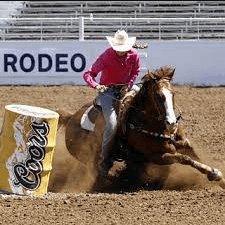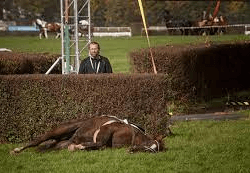What Are The Different Events In A Rodeo?

Rodeos are thrilling events that showcase the skills and talents of both cowboys and cowgirls. They provide a platform for individuals to demonstrate their prowess in various traditional Western disciplines.
From bull riding to barrel racing, roping events to steer wrestling, rodeos offer an array of exciting competitions that captivate audiences from all walks of life.
One of the most iconic events in a rodeo is bull riding. This daring sport involves a rider attempting to stay on the back of a bucking bull for a set period of time. The adrenaline-fueled moments as the rider tries to maintain balance while being tossed around by the powerful animal is an electrifying sight. Bull riding requires immense strength, agility, and courage, making it one of the most intense and dangerous events in rodeo.
Another popular event in rodeos is barrel racing, which showcases speed and precision. In this event, horseback riders navigate a cloverleaf pattern around three barrels placed strategically in an arena as they race against the clock. The tight turns and quick maneuvers required demand exceptional horsemanship skills and coordination between horse and rider. Barrel racing combines elements of speed, athleticism, and strategy into an exhilarating competition that never fails to keep spectators on edge.
Furthermore, roping events such as team roping or tie-down roping also have significant roles in rodeos. Team roping involves two riders working together to capture a running steer using ropes with specific techniques aimed at immobilizing it quickly. Tie-down roping requires individual competitors to rope a calf before dismounting their horse and tying three legs together as fast as possible. Both these events require precise timing, accuracy, and teamwork or individual skillset depending on the competition format.
In conclusion, rodeos encompass various captivating events that highlight both the physical abilities of riders and their connection with animals such as bulls or horses. Bull riding exemplifies bravery while barrel racing emphasizes speed and precision; roping events demonstrate the teamwork or individual expertise needed to successfully capture and control livestock. These events not only entertain but also serve as reminders of the deep-rooted Western heritage and the ongoing pursuit of freedom and self-expression that resonates in the hearts of rodeo enthusiasts.
Bull Riding
Bull riding is considered the most dangerous and thrilling event in a rodeo, showcasing the riders’ skills and bravery while facing unpredictable bulls.
This adrenaline-fueled sport requires not only physical strength but also mental focus and quick reflexes.
Bull riders utilize various techniques to maintain balance and control on the bull’s back, such as using their free hand for balance or shifting their weight to counteract the bull’s movements.
The famous bull riders who have mastered this art form are admired for their ability to stay on the bull for a full eight seconds, which is considered a successful ride.
These skilled athletes have become legends in the rodeo world, inspiring others with their fearless performances and dedication to perfecting their craft.
Barrel Racing
Barrel racing is a thrilling and fast-paced equestrian event that showcases the agility and speed of both horse and rider. This exciting competition involves a horse and rider navigating a cloverleaf pattern around three barrels in the fastest time possible. The sport requires precise control, as riders must guide their horses at high speeds while maintaining balance and avoiding knocking over any barrels.
To fully enjoy barrel racing, one should appreciate the following aspects:
- Skillful Horseback Riding: Riders must possess exceptional horsemanship skills to effectively communicate with their horses during tight turns and quick sprints. They must be able to anticipate their horse’s movements and make split-second decisions to maintain speed without compromising control.
- Western Attire: Barrel racing is deeply rooted in Western culture, which is evident in the attire worn by competitors. Riders typically don cowboy hats, boots, jeans, and flashy shirts adorned with intricate designs or rhinestones. The traditional attire adds an element of authenticity to the event and enhances the overall experience for spectators.
- Precision Turns: One of the most captivating elements of barrel racing is observing how skillfully riders guide their horses around each barrel. The precision required to navigate sharp turns at high speeds demands impeccable timing, coordination, and trust between horse and rider.
- Adrenaline-Fueled Competition: Barrel racing provides an exhilarating spectacle that captivates audiences due to its fast pace nature. As horses gallop full speed down the arena towards each barrel, spectators can feel their own adrenaline surge while watching these incredible displays of athleticism.
- Sense of Freedom: Barrel racing evokes a sense of freedom as riders showcase their mastery over powerful animals in harmony with nature. The bond between horse and rider symbolizes liberation from constraints—a subconscious desire shared by many individuals who yearn for escape from everyday routines.
By appreciating these key aspects of barrel racing such as skillful horsemanship, Western attire, precision turns, adrenaline-fueled competition, and the sense of freedom it embodies, one can truly experience the excitement and beauty of this unique equestrian event.
Roping Events
Roping events are a demonstration of the skill and precision required in roping cattle, showcasing the coordination between horse and rider as they work together to successfully rope and control the animals.
In calf roping, also known as tie-down roping, a rider on horseback chases after a calf and throws a looped rope around its neck. The rider then dismounts the horse, runs to the calf, and ties three of its legs together using a ‘pigging string.’
The event is timed, with the fastest time winning.
Team roping involves two riders working together to capture a steer. One rider, known as the header, ropes the steer’s head while the other rider, called the heeler, ropes both hind legs. The team must demonstrate excellent communication and timing to successfully complete their task.
Both calf roping and team roping require not only physical strength but also mental agility and strategic thinking. These events highlight both the historical significance of roping in ranch work and serve as an exciting display of horsemanship skills at rodeos today.
Frequently Asked Questions
What are the different events in a rodeo other than bull riding, barrel racing, and roping?
Steer wrestling and team roping are two additional events in a rodeo. Steer wrestling involves cowboys attempting to wrestle a steer to the ground, while team roping requires two riders to work together to rope a steer as quickly as possible.
Are there any specific rules and regulations for bull riding, barrel racing, and roping events?
Specific rules, regulations, and safety measures govern bull riding, barrel racing, and roping events. These include requirements for equipment, animal welfare guidelines, time limits, disqualification criteria, and procedures for ensuring the safety of both riders and animals.
How are the participants judged in bull riding, barrel racing, and roping events?
Participants in bull riding, barrel racing, and roping events are judged based on specific criteria. In bull riding, scoring is based on the rider’s ability to stay on the bull for 8 seconds. Barrel racing is scored by time, while roping events are judged on speed and accuracy. Animal welfare regulations are implemented to ensure the safety and well-being of the animals involved in these events.
Are there any safety measures in place for both the participants and the animals involved in these events?
Safety measures for rodeo participants and animals are of utmost importance, reflecting the significance placed on animal welfare. Strict regulations govern equipment standards, veterinary care, and participant training to ensure the well-being of all involved in these exhilarating events.
Are there any age restrictions or specific qualifications for participating in bull riding, barrel racing, and roping events?
Age restrictions and specific qualifications vary for each event in a rodeo. Bull riding typically requires riders to be at least 18 years old, while barrel racing and roping events may have different age categories or divisions based on skill level.
Conclusion
In conclusion, the rodeo is a thrilling and competitive event that showcases various skills and talents.
Bull riding, one of the most popular events in a rodeo, requires immense strength and balance as riders attempt to stay on a bucking bull for eight seconds. This event not only tests the cowboys’ physical abilities but also their mental fortitude as they face the unpredictable nature of these powerful animals.
Another exciting event in a rodeo is barrel racing, where female riders demonstrate their speed and agility while maneuvering around barrels in a cloverleaf pattern. The precision required to navigate through tight turns at high speeds adds an element of challenge to this fast-paced competition.
Additionally, roping events exhibit remarkable teamwork between horse and rider as they work together to rope cattle swiftly and accurately.
An interesting statistic that adds depth to the discussion is that bull riding has been recognized as one of the most dangerous sports in terms of injuries sustained by participants. According to data from the Professional Rodeo Cowboys Association (PRCA), bull riding accounted for 48% of all rodeo-related injuries between 1989 and 2009. This statistic emphasizes the risks involved in this intense sport and highlights the bravery exhibited by bull riders who willingly face these dangers.
In summary, rodeos offer a diverse range of events that captivate audiences worldwide. From bull riding’s display of strength and courage to barrel racing’s demonstration of speed and precision, each event showcases unique skills honed through years of practice.
The dangerous nature of bull riding further underscores the dedication required by participants who risk injury for their passion. With its rich history rooted in cowboy culture, the rodeo remains an iconic symbol of Western heritage and continues to enthrall spectators with its thrilling competitions.





